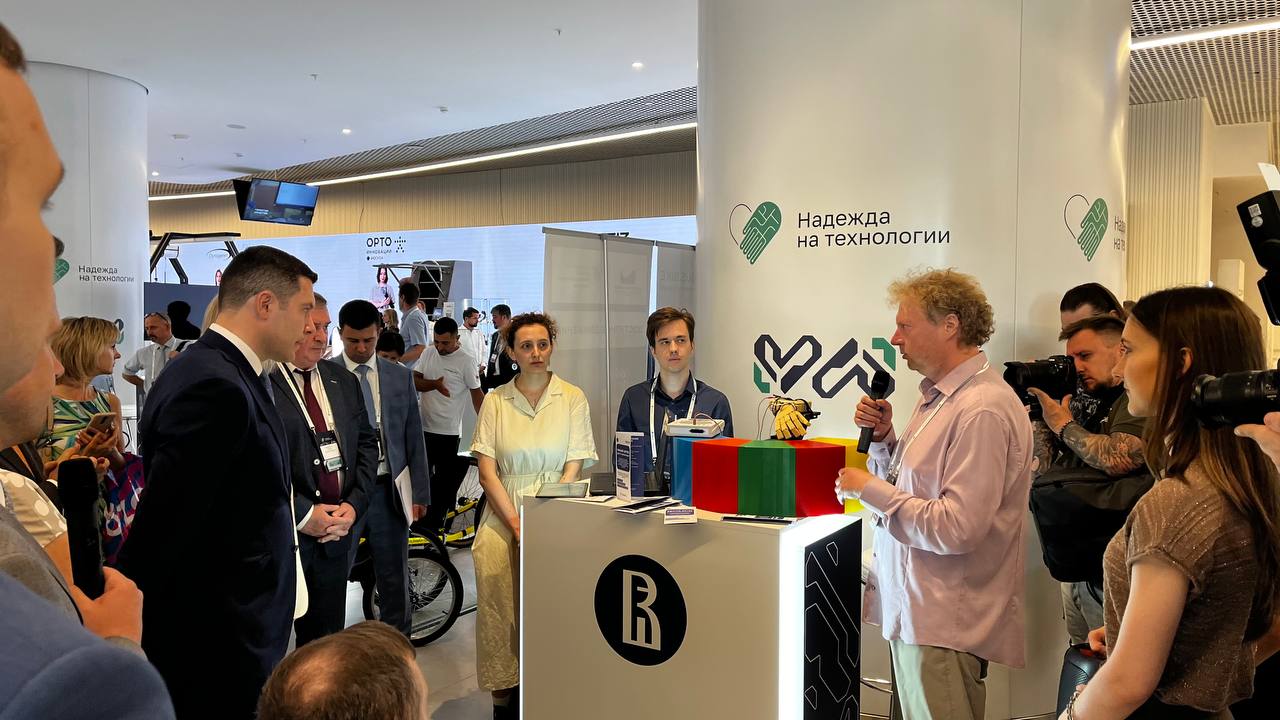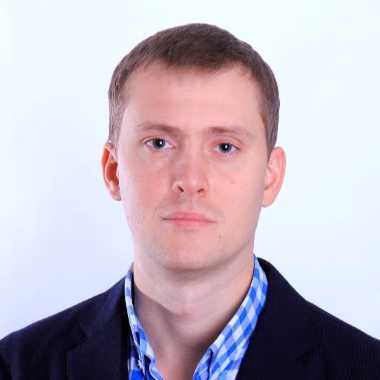HSE University Presents Smart Orthosis at Hope for Technology Forum

On July 10–11, 2025, Moscow hosted the 10th Hope for Technology National Forum of the Rehabilitation Industry and Universal Design. The event was aimed at discussing innovative achievements in the rehabilitation industry. The MIEM Student Design Bureau and the HSE Institute for Cognitive Neuroscience presented a smart orthosis, which was developed at the request of orthopedists.
The Smart Orthosis project is a comprehensive rehabilitation system geared towards helping in the development of motor activity in patients (primarily children) who experience difficulty bending their arm at the elbow joint. The system operates on the basis of an electromyographic signal (EMG). The developers guarantee an individual approach with automatic personal adjustment to the individual characteristics of the patient. This development solves several rehabilitation problems at once: it increases the effectiveness of surgical intervention, reduces dependence on third parties (psychologists, parents) in existing rehabilitation programmes, and improves the ability to monitor the recovery process.
Evgeny Blagoveshchensky, Leading Research Fellow at the Centre for Cognition & Decision Making of the Institute for Cognitive Neuroscience, notes that the idea to develop an orthosis arose following the request of orthopedists as a result of cooperation between HSE University and the G. Turner National Medical Research Center for Pediatric Orthopedics and Trauma Surgery of the Ministry of Health of the Russian Federation. ‘In Russia, rehabilitation processes are often standardised, and personal programmes are an exception. Initially, we tried to find ready-made solutions, but they were unavailable even on the global market. This prompted us to create our own solution. Thanks to specialists from the MIEM Design Bureau, we managed to create the first prototype, which was presented at the exhibition. It is an exoskeleton with assistive functions that can adapt to the patient's needs. We hope to put it into production soon,’ adds Blagoveshchensky.

The orthosis consists of a mechanical exoskeleton, software, a biofeedback system, a digital gaming platform, and myography sensors. The intelligent system will analyse the patient's movements and adjust to them, providing fixation in the hand and biceps area and precise movement control.
The project was well received by forum guests and Minister of Industry and Trade Anton Alikhanov, who expressed interest in the implementation of the product and its potential for further application in daily practice.

Dmitry Kovalenko
Dmitry Kovalenko, HSE University Vice Rector and Director of HSE MIEM, says that the renewed Student Design Bureau at MIEM is intended to become an innovative hub for supporting student design developments aimed at further widespread implementation. ‘This means comprehensive organisational, methodological and substantive support, as well as the development of optimal models for the institute's interaction with partner companies and customers. The smart orthosis is the first step, a kind of pilot project. It’s great that it was highly praised by experts in science and the real sector,’ he adds.
During the forum, specialists from the MIEM Student Design Bureau and the HSE Institute for Cognitive Neuroscience held talks with representatives of potential partner companies of the project.

Ilya Ivanov
Ilya Ivanov, Leading Research Fellow at the School of Electronic Engineering of the HSE Tikhonov Moscow Institute of Electronics and Mathematics and Head of the MIEM Design Bureau, comments: ‘We consider healthcare to be one of our current priorities. It’s a huge field for the application of AI technologies. Our students are happy to participate in such projects, both because there are many truly non-trivial and creative tasks, and because these tasks are aimed at achieving perhaps the most worthwhile goals—preserving human health and helping with rehabilitation.’

Veronika Prokhorova
Veronika Prokhorova, MIEM's Deputy Director for Project Work, notes that the MIEM Design Bureau, where students implement technological product projects, has already established fruitful partnerships with large manufacturers of various modern equipment, as well as among leading HSE departments. ‘We value these partnerships and hope to present other developments of the design bureau in the near future,’ adds Prokhorova.
For more news about the activity of the HSE MIEM Design Bureau, please see the official Telegram channel (in Russian).
About the Hope for Technology Forum
The forum was held on July 11–12 in Moscow at the Lomonosov Cluster of the Moscow State University Innovation Centre. The participants, including leading experts in the field of healthcare, rehabilitation technologies, representatives of ministries, government agencies, and large equipment manufacturers, had an opportunity to learn more about advanced developments and integrated solutions aimed at creating a barrier-free environment, as well as the latest technological solutions designed to make life easier for people with disabilities and limited mobility.
See also:
HSE Scientists Optimise Training of Generative Flow Networks
Researchers at the HSE Faculty of Computer Science have optimised the training method for generative flow neural networks to handle unstructured tasks, which could make the search for new drugs more efficient. The results of their work were presented at ICLR 2025, one of the world’s leading conferences on machine learning. The paper is available at Arxiv.org.
Physicists Propose New Mechanism to Enhance Superconductivity with 'Quantum Glue'
A team of researchers, including scientists from HSE MIEM, has demonstrated that defects in a material can enhance, rather than hinder, superconductivity. This occurs through interaction between defective and cleaner regions, which creates a 'quantum glue'—a uniform component that binds distinct superconducting regions into a single network. Calculations confirm that this mechanism could aid in developing superconductors that operate at higher temperatures. The study has been published in Communications Physics.
Neural Network Trained to Predict Crises in Russian Stock Market
Economists from HSE University have developed a neural network model that can predict the onset of a short-term stock market crisis with over 83% accuracy, one day in advance. The model performs well even on complex, imbalanced data and incorporates not only economic indicators but also investor sentiment. The paper by Tamara Teplova, Maksim Fayzulin, and Aleksei Kurkin from the Centre for Financial Research and Data Analytics at the HSE Faculty of Economic Sciences has been published in Socio-Economic Planning Sciences.
Larger Groups of Students Use AI More Effectively in Learning
Researchers at the Institute of Education and the Faculty of Economic Sciences at HSE University have studied what factors determine the success of student group projects when they are completed with the help of artificial intelligence (AI). Their findings suggest that, in addition to the knowledge level of the team members, the size of the group also plays a significant role—the larger it is, the more efficient the process becomes. The study was published in Innovations in Education and Teaching International.
New Models for Studying Diseases: From Petri Dishes to Organs-on-a-Chip
Biologists from HSE University, in collaboration with researchers from the Kulakov National Medical Research Centre for Obstetrics, Gynecology, and Perinatology, have used advanced microfluidic technologies to study preeclampsia—one of the most dangerous pregnancy complications, posing serious risks to the life and health of both mother and child. In a paper published in BioChip Journal, the researchers review modern cellular models—including advanced placenta-on-a-chip technologies—that offer deeper insights into the mechanisms of the disorder and support the development of effective treatments.
Advancing Personalised Therapy for More Effective Cancer Treatment
Researchers from the International Laboratory of Microphysiological Systems at HSE University's Faculty of Biology and Biotechnology are developing methods to reduce tumour cell resistance to drugs and to create more effective, personalised cancer treatments. In this interview with the HSE News Service, Diana Maltseva, Head of the Laboratory, talks about their work.
Solvent Instead of Toxic Reagents: Chemists Develop Environmentally Friendly Method for Synthesising Aniline Derivatives
An international team of researchers, including chemists from HSE University and the A.N. Nesmeyanov Institute of Organoelement Compounds of the Russian Academy of Sciences (INEOS RAS), has developed a new method for synthesising aniline derivatives—compounds widely used in the production of medicines, dyes, and electronic materials. Instead of relying on toxic and expensive reagents, they proposed using tetrahydrofuran, which can be derived from renewable raw materials. The reaction was carried out in the presence of readily available cobalt salts and syngas. This approach reduces hazardous waste and simplifies the production process, making it more environmentally friendly. The study has been published in ChemSusChem.
Master’s Students of HSE, University of Campinas, and Tsinghua University Publish Joint Student Research Collection
Master’s students of the HSE ISSEK programme ‘Science, Technology and Innovation Management and Policy’ have released a joint research collection with the University of Campinas (Brazil) and Tsinghua University (China) titled ‘Being Innovative or Being on the Safe Side—Managing the Risk of Failure.’ The authors explore how organisations perceive risks and embrace innovation within different cultural contexts.
‘A Turn Away from Stereotypes’: Moscow Hosts ‘Researching the Deaf Community’ Conference
On October 17–19, 2025, the third annual interdisciplinary conference ‘Researching the Deaf Community 2025: on the Periphery of Attention’ took place at GES-2 House of Culture in Moscow. The event was organised with the participation of the HSE International Laboratory for Social Integration Research. HSE University Vice Rector Irina Martusevich addressed attendees at the opening ceremony.
Exploring the Mind: HSE Scientists Discuss Cognitive Technologies of the Future
Why we make irrational decisions, how the brain responds to fakes, and whether neural networks are capable of thinking—these were the topics discussed by early-career scientists of HSE University during the NAUKA 0+ science festival. The event brought together students and experts from various fields, united by a common goal—to deepen their understanding of the human brain and cognitive technologies.


